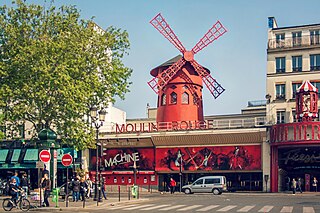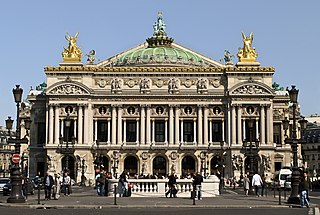
Moulin Rouge is a cabaret in Paris, on Boulevard de Clichy, at Place Blanche, the intersection of, and terminus of Rue Blanche.

Montmartre is a large hill in Paris's northern 18th arrondissement. It is 130 m (430 ft) high and gives its name to the surrounding district, part of the Right Bank. Montmartre is primarily known for its artistic history, for the white-domed Basilica of the Sacré-Cœur on its summit, and as a nightclub district.

The 9th arrondissement of Paris is one of the 20 arrondissements of the capital city of France. In spoken French, it is referred to as le neuvième.

Pigalle is an area in Paris, France, around the Place Pigalle, on the border between the 9th and the 18th arrondissements. It is named after the sculptor Jean-Baptiste Pigalle (1714–1785).

The Place Pigalle is a public square located in the 9th arrondissement of Paris, between the Boulevard de Clichy and the Boulevard de Rochechouart, near Sacré-Cœur, at the foot of the Montmartre hill.

Pigalle is a station on lines 2 and 12 of the Paris Métro, named after the Place Pigalle, which commemorates the sculptor Jean-Baptiste Pigalle (1714–1785) on the border of the 9th and the 18th arrondissement. The station is located under the Boulevard de Clichy in Montmartre and serves the famous Pigalle red-light district.

The Nouvelle Athènes, or Café de la Nouvelle-Athènes, was a café located at 66 Rue Pigalle in the Place Pigalle in Paris, France. It was the setting for many Impressionist paintings, as a result of being the meeting place for painters, including Matisse, Van Gogh and Degas.

Anne Pigalle is a French singer and multimedia artist.

The Musée de Montmartre is located in Montmartre, at 8-14 rue Cortot in the 18th (XVIII) arrondissement of Paris, France. It was founded in 1960 and was classified as a Musée de France in 2003. The buildings were formerly the home of several famous artists, including Pierre-Auguste Renoir and Suzanne Valadon.

The Boulevard de Clichy is a famous street of Paris, which lends its name to the Place de Clichy, resulted from the fusion, in 1864, of the roads that paralleled the Wall of the Farmers-General, both inside and out. It extends from the Place de Clichy to the Rue des Martyrs, nearly a kilometre away. During its tenure, the street has been known as the Boulevard des Martyrs, then the Boulevard Pigalle, and, finally, the Boulevard de Clichy. It is equally well known as the Boulevard Clichy.
Alfred-Adolphe Pasquali was a French actor and theatre director.

The name Concert Mayol refers to a former cabaret situated at 10 rue de l'Échiquier in the 10th arrondissement of Paris.

Bintou Dembélé is a dancer and a choreographer who is recognized as one of the pioneer figures of Hip hop dance in France. After having danced for more than thirty years in the Hip Hop world, Bintou Dembélé has been the artistic director of her own dance company Rualité since 2002. Her work explores the issue of the memory of the body through the prisms of colonial and post-colonial French history.

Cabaret de l'Enfer was a famous cabaret in Montmartre, founded in November 1892 by Antonin Alexander and demolished in 1950 to allow for the expansion of a Monoprix supermarket. The Cabaret de L'Enfer was the counterpart to The Cabaret du Ciel, another cabaret which shared the same address on the Boulevard de Clichy. Antonin Alexander was the creator, director, and host of the twin ventures.

Madame Arthur is the first gender-twist cabaret in France, opened in 1946, taking its name from the famous song written in 1860 by Paul de Kock and performed by Yvette Guilbert.

Georgette Anys was a French film and television actress. A character actress, she appeared mainly in French productions, but also some American films which were shot in Europe including Alfred Hitchcock's To Catch a Thief in which she plays Cary Grant's housekeeper Germaine.

Louise Pioger, also known as Louise Quitrime, was born on June 19, 1848, in Mezières-sous-Ballon, France, and died on December 9, 1920 in Garches. She was a woman laborer in the clothing and textile industry. She made waistcoats and was also an anarchist author and communard active with Women in the Paris Commune. She is known for her nursery rhymes book titled Rondes pour récréations enfantines, which was for a long time wrongly attributed to Louise Michel.
Le Carrousel de Paris was a Parisian cabaret most famous for its 1950s revues of cross-dressing and trans performers such as Coccinelle. It definitively ceased its dinner-show activity in 2016.
New Moon was a Parisian nightclub, located at 66 Rue Pigalle in the Place Pigalle, that started in the late 19th-century as a headquarters for Impressionist artists. In the 20th century, it became a jazz club and then a lesbian cabaret, before converting to a well-known alternative rock club in the 1980s. It closed in 1995.


















